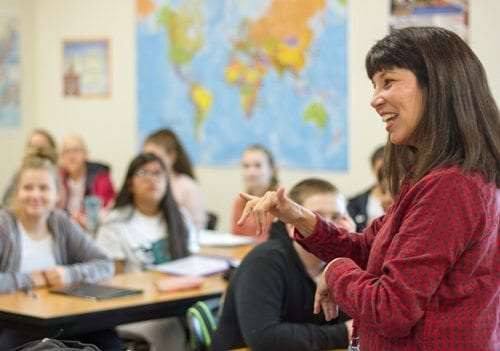
As reported by NPR the Deaf community scored a major victory when the Los Angeles Unified School District (LAUSD) approved a bilingual program for deaf and hard of hearing students.
The second largest school district in the country now has a program that will teach those students American Sign Language (ASL) and English by default. Despite the numerous benefits to providing deaf students with greater access to ASL, there are still parents who object, and the implementation of the program has not gone smoothly.
One of the greatest challenges facing deaf and hard of hearing youth these days is equal access to communication.
With traditional deaf schools closing worldwide it is more important than ever to give these students every linguistic opportunity to succeed. One report by the National Deaf Children’s Society in England found that deaf education facilities are closing at a rate of 10 per year: now down to only 240. This has led to many deaf students to be placed in traditional public schools. They rely on interpreters and/or captioning in order to learn the material. This type of environment severely limits deaf and hard of hearing’s ability to socialize as few to none of their hearing classmates are able to easily communicate with them. This leaves them not only socially but linguistically deprived as well.
Hearing people take for granted the amount of peripheral language they are exposed to on a daily basis. Whether through vicarious conversations, radio, and television for example, hearing people have much greater access to language. Some estimates suggest that the average person speaks 7,000 words and hears roughly 30,000 words every single day. Now think of a deaf student who typically don’t have friends or family who are fluent in ASL. Their only exposure is via an interpreter for a few hours a day. If they are lucky there may be a few other classmates they can socialize with during breaks, but that’s often not the case especially in rural schools. Let’s imagine that the deaf student only speaks 2,000 words a day and is exposed to 10,000 words a day. This is being generous since when there is no school, these numbers likely drop dramatically. Over the course of just one year, the deaf child will ‘hear’ 7.3 million less words than a hearing child. It is obvious something needs to be done to bridge this gap.
One of the best ways to help deaf children is by providing them with as much access to ASL as possible.
Ensuring that their education is at least balanced with ASL and English will enable them better develop linguistically and socially. After all, the greatest skills in life are social. Delays in language will not only affect their social abilities, but their confidence and education in general. LAUSD has taken an important step in that direction by mandating ASL be taught as well as English to all students aged 0 to 3. This will have clear benefits for those children in the long run. Despite the victory, the district is still struggling to effectively implement the necessary changes to support those children. Many advocates are being left in the dark and only vague promises have been made by the district. Let’s hope that these are simply growing pains, and that the district truly has good intentions for these disadvantaged students.
The Los Angeles School District will also start offering more ASL classes.
By providing more access to ASL, hearing students will not only have access to a second language, reaping all of the benefits of being bilingual, they will better be able to communicate with their deaf classmates. In addition to making deaf students feel more included, bolstering their esteem and motivation to attend school, hearing students will gain compassion and insight by removing the mystery of what goes on in the deaf world.
Science supports ASL
I believe that science will prevail and that the benefits of learning ASL will win over the doubters who hang onto irrational fears. Some parents are afraid that ASL will delay their child’s English skills. There is no evidence to support this, and in fact growing evidence to the contrary. Babies who were taught ASL ended up speaking much earlier than those who did not learn ASL. Sign Language benefits all those who learn it.
There are great benefits to exposing deaf and hard of hearing children to ASL and English as early as possible.
Let us celebrate this important step in childhood education and inclusion. Let us constructively criticize the mistakes that LAUSD may make in the process, but with the purpose of making this program a success for those who desperately need it. Pressure those who are not fully on board to educate themselves and choose ASL education experts to guide the bilingual program towards the goal of linguistically empowering the next generation to become proud and inclusive leaders.
At Spot On Interpreting we aim to promote inclusion at school, work, and in daily life by providing professional ASL interpreters.
Providing equal access to communication is a fundamental step in abiding by the Golden Rule. Treat the Deaf as you would want to be treated if you were Deaf. Give them the same opportunities for life, liberty, and the pursuit of happiness that we should all be afforded.
Spot On Interpreting provides Spanish and Sign Language interpreters for the Los Angeles, Long Beach, Anaheim, Santa Ana, and Irvine Areas. We also have access to over 70 other language interpreters and translators. Family owned and operated since 2010.
